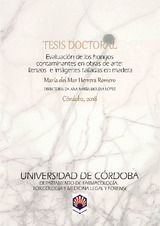Evaluación de los hongos contaminantes en obras de arte: lienzos e imágenes talladas en madera
Autor
Herrera Romero, María del Mar
Director/es
Molina López, Ana MaríaEditor
Universidad de Córdoba, UCOPressFecha
2018Materia
Contaminantes biológicosMohos
Hongos microscópicos
Aspergillus níger
Penicillium candidum
Obras de arte
Lienzos de cuadros
Maderas de esculturas
METS:
Mostrar el registro METSPREMIS:
Mostrar el registro PREMISMetadatos
Mostrar el registro completo del ítemResumen
En este trabajo hemos descrito con el microscopio óptico (MO) y microscopio electrónico
de barrido (MEB) y transmisión (MET), los diferentes componentes: vesículas, métulas, fiálides,
conidios y esporas del Penicillium candidum y Aspergillus níger. Los hongos proceden de telas
de cuadros, que se han visto afectados por su contaminación.
Como objetivos del trabajo nos planteamos en primer lugar conocer la viabilidad de estos
hongos contaminantes. Conocer la morfología a través de los estudios al MO y MEB y finalmente
conocer la evolución mediante el análisis morfológico con el MET. Por otro lado existen
numerosas descripciones al MO y MEB de los componentes celulares de Aspergillus y
Penicillium. En cambio son escasos e incompletos los estudios descriptivos que existen en la
bibliografía consultada, con la utilización del MET, de las células eucariotas de estos hongos, por
lo que se puede considerar una importante aportación para su conocimiento y funcionamiento,
sobre todo de las métulas y fiálides.
Es importante conocer las granulaciones que se presentan en las métulas y fiálides, que
participan activamente en la defensa de estos hongos. Son granulaciones específicas y similares
en ambos hongos, Y hay que señalar las granulaciones proteicas y de mediana densidad electrónica que presentan estas células y que definitivamente son las responsables de la
producción de las envueltas de las esporas. En cambio existe una diferencia importante en las
granulaciones de Aspergillus níger en comparación con Penincillium. En Aspergillus se producen
granulaciones muy densas a los electrones y que se identifican con melanina, protegiendo
selectivamente a este hongo. In this manuscript, we have described the different components, vesicles, metulae,
phialides, conidia and spores of Penicilliumcandidum and Aspergillusniger with the scanning
electron microscope (SEM) and transmission electron microscope (TEM). The fungi come from
plaid fabrics, which have been affected by their contamination.
As objectives of the work, firstly to know the viability of these contaminating fungi.To
know the morphology through the studies with MO and SEM and finally to know the evolution
through the morphological analysis with TEM. On the other hand there are numerous descriptions
to MO and SEM of the cellular components of Aspergillus and Penicillium. In contrast, the
descriptive studies that exist in the literature consulted, with the use of TEM, of the eukaryotic
cells of these fungi are scarce and incomplete, so that it can be considered an important
contribution for their knowledge and functioning, especially of the metulae and phialides.
One of the most important facts is to know the granulations that occur in the metulae and
phialides, which participate actively in the defense of these fungi. As specific and similar
granulations in both fungi, it is necessary to point out the proteinic and medium electron density
granulations that these cells present and that are definitely responsible for the production of the spore shells. In contrast, there is a significant difference in the granulations of the
Aspergillusniger compared to the Penicillium; Aspergillus produces very dense granulations to the
electrons and that are identified with melanin, which selectively protect this fungus.

